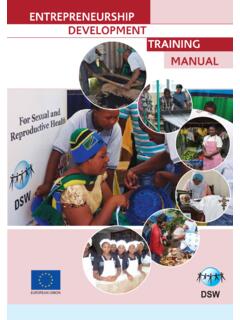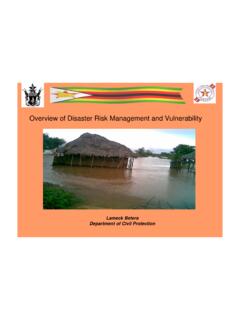Transcription of Protection Principles - Orange
1 Sphere handbook Draft 2 for consultation Protection Principles October 2017 1 Protection Principles Protection is concerned with the safety, dignity and rights of people affected by disaster or armed conflict. It is central to all humanitarian action because it helps people avoid or recover from violence, coercion and deliberate deprivation. The Humanitarian Charter summarises some of the fundamental rights related to humanitarian response and the Principles of humanitarian action. It includes the right to Protection and security. The state has primary responsibility for protecting people affected by a crisis. However, when the state is unable or unwilling to act, all humanitarian actors have a role to play, engaging collectively to achieve meaningful Protection outcomes for the affected population. This chapter describes three Protection Principles that should inform all humanitarian responses.
2 The Protection Principles apply to all humanitarian actors and to all stages of humanitarian action--from preparedness through response and recovery. These Principles also connect Protection , the Humanitarian Charter, the Core Humanitarian Standard and the sectoral Minimum Standards. All of these elements combine to reinforce the right to life with dignity and the right to humanitarian assistance and the right to Protection . Understanding Protection The most widely accepted definition describes Protection as: .. all activities aimed at obtaining full respect for the rights of the individual in accordance with the letter and the spirit of the relevant bodies of law (that is, International Human Rights Law (IHRL), International Humanitarian Law, International Refugee law (IRL)). --Inter-Agency Standing Committee (IASC) Protection work requires engaging with affected people during all phases of a humanitarian response to understand risks, threats, capacities and how people take steps and make choices to protect themselves.
3 To bring a Protection lens into their work, humanitarian actors need to: understand the context and take steps to prevent, mitigate, or end potential and actual risks; be sensitive to people s age and gender; consider diversity within the affected population; and respect the ability of people to make decisions about their own situation and recovery. Specialist Protection activities includes educating duty bearers and rights holders: Sphere handbook Draft 2 for consultation Protection Principles October 2017 2 Duty bearers - those with a recognised obligation and responsibility so they understand, respect, protect and fulfil the rights of affected people under international law; and Rights holders - affected people so they know their rights and how to exercise them. Three Protection Principles 1. Prevent: Enhance the safety, dignity and rights of affected people, and avoid exposing people to further harm; 2.
4 Respond: Reduce the impact of physical and psychological harm that arises from violence, coercion, deliberate deprivation and other threats; and 3. Remedy: Assist people to claim their rights and access appropriate remedies. These three Principles may be inter-dependent and carried out at the same time. The Principles promote the right to dignity in three ways: mainstreaming Protection risks, activities and related information across all humanitarian programmes; integrating specific Protection objectives into assistance projects; and promoting specific and/or specialised Protection activities that address specific Protection risks and violations. Protection mainstreaming across humanitarian programmes Protection mainstreaming refers to the process of building Protection Principles into all aspects of humanitarian response. It requires humanitarian organisations to address Protection threats and opportunities by considering: who is at risk, from what, whom and why; what vulnerabilities and capacities do people have relative to the threats, and how can programmes be adapted in response to these; and how and where to refer people for specialist support in preventing or recovering from violence and exploitation.
5 Integrating Protection into sectoral responses Protection integration involves incorporating specific Protection objectives into sectoral responses, such as nutrition or shelter. It requires humanitarian actors to set specific, measurable Protection objectives for their response. Doing so prompts different actors to work individually and together as part of a multi-sector humanitarian response. It therefore makes Protection a central consideration. Sphere handbook Draft 2 for consultation Protection Principles October 2017 3 Specific or specialised Protection activities Organisations and practitioners with Protection expertise provide specialised activities and services that address specific threats, violations and risks. Specific Protection programmes should fulfil the Sphere Protection Principles , and meet the Professional Standards for Protection Work (ICRC, 2017).
6 Guidance also exists for child Protection , gender-based violence, mental health and other specialised areas. Details of these and other relevant resources are provided at the end of this chapter. Advocacy Advocacy links the three Protection Principles and the three types of activities. Where threats to the affected population come from deliberate decisions, actions or policies, humanitarian or human rights organisations can advocate for changes to those behaviours or policies. Successful advocacy may include persuasion, as well as more explicit denunciation approaches. In all cases advocacy depends on reliable evidence, understanding the stakeholders in the situation, and a thorough analysis of context. It requires an environment that encourages respect for the rights of all people in accordance with international law. Evidence such as witness statements, population profiles, and images that allow people to be identified may be highly sensitive, and can put people at risk.
7 They should be treated with care. See Protection Principle 1 below. Sphere handbook Draft 2 for consultation Protection Principles October 2017 4 Protection Principles Protection Principle 1: Prevent Enhance the safety, dignity, and rights of affected people, and avoid exposing people to further harm. Humanitarian response takes place in dynamic, volatile, and insecure environments. Those working in humanitarian action need to: understand the context; identify and understand Protection issues, including the role and ability of primary duty bearers; and take appropriate steps to reduce overall risk to affected people. In practice, this means actively working to decrease threats, reduce vulnerability to risk, and enhance capacities that prevent exposure to risks. Effective communication, analysis and accountability are central to this principle.
8 This principle complements and is key to fulfilling Core Humanitarian Standard Commitment 3: Communities and people affected by crisis are not negatively affected and are more prepared, resilient and less at-risk as a result of humanitarian action. What else do I need to know? Understanding the context Understand how people try to protect themselves, their families and their communities from harm. Design activities that support, and do not undermine, this capacity for self- Protection . Work with the affected people to do regular Protection risk analyses of the context. The following checklist is useful any practitioner can use it and adapt it to the situation, What are the Protection risks (threats, vulnerabilities and capacities)? Who are the at-risk groups? What are their specific Protection concerns? For example, based on race, caste, class, gender, age or sexuality.
9 What are local communities doing to protect themselves? How can they increase engagement? How can humanitarian organisations support and not undermine these efforts? Do the affected people s own activities result in negative consequences to their Protection ? For example, by early marriage, risky migration or engaging in transactional sex. Is there a way to change their actions? Do programme activities have unintended negative consequences? For example, on the environment or community power dynamics? Is there a way to mitigate those consequences? Are activities validating or giving legitimacy to the policies and practices that cause the problem? For example, do activities strengthen the position of armed groups or other actors by recognising their authority to grant title deeds? Does the legislation/policy of the context or specific activities discriminate or create the perception of discrimination against any group?
10 For example, criminalisation of same sex relationships? Sphere handbook Draft 2 for consultation Protection Principles October 2017 5 Does protecting and promoting the rights of such groups have an impact on relationships within and beyond the community? What are the biggest obstacles preventing at-risk groups from participating or accessing services? For example, illiteracy, disability , age. What enables their participation and access? For example, information products in braille. Programme design, activities and risks Design programme activities that consider findings from the risk analysis. Actively look for ways to minimise threats and vulnerabilities. Examples include communicating GPS coordinates (for hospitals and clinics where safe to do so in a conflict situation), or providing information during epidemics to reduce the spread of rumours.



